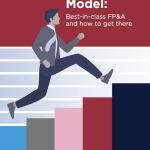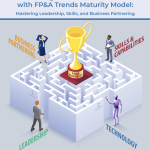There has never been greater uncertainty and a faster pace of change than over the past...

How do we fail at digital transformation? You may be wondering, “Did I read this right?” Is the author providing me insights on failing in my multimillion-dollar transformation project? Yes, you are reading it right. Charlie Munger, the wise Business Partner of Warren Buffett, had a golden rule about strategy and life in general – “Invert, always, invert”. What he meant was to turn the problem upside down and think backwards. If you want to succeed in digital transformation, focus on what factors may cause its failure. Have a laser focus on the shortcomings and implement strategies to avoid those failures.
This article aims to share some insights on why digital transformation in finance has failed in other companies and which important lessons we can learn from those experiences.
Digital transformation became a buzzword during the COVID-19 pandemic. Finance departments are generally slow to adapt to change. That is why many companies still have old legacy finance systems which are not well integrated with other systems. The resistance to change for financial and other considerations exists in many companies. But COVID changed all that – it forced us to quickly adapt to work remotely – tasks that were thought impossible to do outside offices had to and were done from home. In one of the companies that I worked for, it was inconceivable that Account Payable (A/P) activities could be done remotely. However, during the pandemic, all A/P activities were done efficiently and accurately. The pandemic also helped senior finance leadership realise that digital transformation could provide efficiencies and cost savings.
Why Is Digital Transformation Beneficial?
Digital transformation provides many benefits: data-driven insights, it encourages collaboration, drives efficiencies, and enables the finance function to focus more on value-adding activities. While the benefits are great, a few recent research provide some stunning statistics outlined below.
- The Forbes survey evaluates the risk of failure in digital transformation at ~84%1;
- According to a recent KPMG Survey, most US businesses say they have not seen an increase in performance or profitability from digital transformation investments in the previous 24 months2.
The above surveys highlight the need to study why digital transformations have failed and how to avoid those mistakes. So, let’s look at some of the most common mistakes.
Be reactionary and don’t have a clear business strategy
This is a sure short way to fail at transforming the FP&A function. According to KPMG, many technology initiatives are largely driven by a reaction to hype rather than a clear business strategy, ultimately resulting in wasted spending. The most important element in any transformation project should be clear business objectives. These objectives can vary depending on the size, the company’s maturity and experience with transformation initiatives. For instance, I worked in a business with an inefficient A/P process, but the CFO of this company had a clear idea of transforming it to allow the A/P team to focus on more value-added activities. The CFO was very clear in his vision for the A/P team and the business objective for the digital transformation.
Don’t get top management buy-in
Digital transformation can be time-consuming and expensive. Thus, it is imperative to get top management buy-in. Practically speaking, many companies are hesitant to invest heavily in the FP&A function. Since there is no direct ROI, companies would prefer to invest in marketing or sales where the return is faster and more tangible. It is necessary for the CFO to drive the business case for a digital transformation, and some of the key questions to answer are as follows:
- What are the expected benefits of the digital transformation of the FP&A function?
- Are there any tangible benefits of such a program? Any cost savings or measurable efficiencies?
- What are the timelines for achieving these results?
- How does this transformation tie in with the overall business strategy?
- Has the company invested in other transformation projects and successfully delivered them?
By quantifying the benefits and linking transformation to the business strategy, it will be easier to convince top management.
Ignore the people
Per the KPMG 2023 survey, the top factors to fail digital transformation were a lack of skills within the organisation, a risk-averse culture that is slow to embrace change and a lack of coordination. I would broadly categorise these as the people factor. A few relevant questions to consider before embarking on a transformation program are:
- Do we have a culture of open communication, and do we embrace change? Have we done other transformation projects? Did these succeed or fail?
- There may be scepticism around a new transformation program – are we clearly identifying and communicating the objectives behind the program?
- A transformation program may lead to a change in the roles of some people. Are we providing new tools to perform these roles effectively?
- Do we have a clear roadmap with roles and responsibilities for the program?
- How are we coordinating the various departments, and what frameworks do we have in case of conflict?
Finally, a digital transformation program can be successful only when the team buys in, commits to the project and works collaboratively with each other. Almost all programs face headwinds during implementation, and that is normal. However, if the roles and their accountability are clear and if there is a focused effort to see through the transformation, then it will be a success.
Choose the wrong technology vendor
The market is flooded with so many different technologies and vendors. Which one is the right for your company? There is no easy answer, but there are some good questions that can help you reach the right decision.
- What is the size and budget of your company? Once, we were evaluating products from different vendors and understood that the chosen solution was not the right fit for my company, as the implementation costs outweighed other benefits.
- Does the product align with the actual needs of the organisation?
- Is there a cost-efficient product with must-have features instead of an expensive product with good-to-have options?
Legacy systems
One can hardly overstress the importance of this factor. A lot of companies use legacy systems and many finance processes are linked with these systems.
- What is the strategy around legacy systems? Do you plan to phase these out or keep them?
- Do the new products talk to the legacy system?
Data security
Today, data is like gold, and organisations are spending millions of dollars to protect their data.
- Does the product have robust security features?
- It would be good to have a third-party security consultant review the products and ask them to provide an independent point.
Conclusion and Recommendations
As a finance leader, you may think, “Wow, that is a lot to consider”, and it definitely is. Finance transformation is a huge project. With a 70-80% failure rate, it is a very high-risk project. Having the right tools and frameworks can help us mitigate these risks. To conclude, I would like to outline a few ways to ensure a successful finance transformation:
- Have a clear strategy and align it with business goals,
- Get management buy-in,
- It is all about the people,
- Invest the time to select the right vendor.
References:
- ROGERS, Bruce. "Why 84% of Companies Fail at Digital Transformation." Forbes. January 7, 2016. Accessed March 15, 2024. https://www.forbes.com/sites/brucerogers/2016/01/07/why-84-of-companies-fail-at-digital-transformation/
- KPMG. "KPMG Survey: Majority of US businesses say they have not seen an increase in performance or profitability from digital transformation investments." KPMG.com. Accessed March 15, 2024. https://info.kpmg.us/news-perspectives/technology-innovation/kpmg-us-tech-survey-report-findings.html
Subscribe to
FP&A Trends Digest

We will regularly update you on the latest trends and developments in FP&A. Take the opportunity to have articles written by finance thought leaders delivered directly to your inbox; watch compelling webinars; connect with like-minded professionals; and become a part of our global community.






